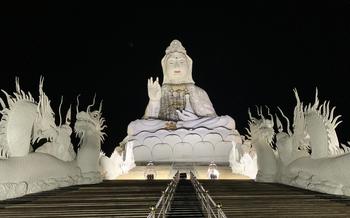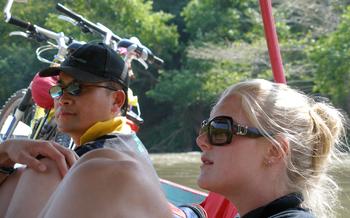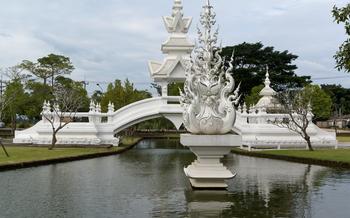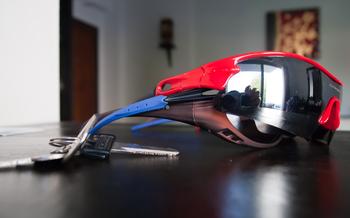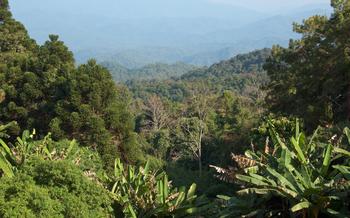
Tribal Museum Mae Hong Son
- The Tribal Museum in Mae Hong Son: A Unique Experience
- The History of the Museum
- The Collection
- The Tribes of Mae Hong Son
- The Cultural Significance of the Museum
- The Museum's Educational Programs
- The Museum's Contribution to Tourism
- The Museum's Collaboration with Local Communities
- Challenges and Opportunities
- Must-See Exhibits
- Unique and Rare Artifacts
- Interactive Displays and Multimedia Presentations
- Personal Stories and Testimonials
- Local Culture and Cuisine
- Explore the Surroundings
- Photography Tips
- Best Time for Photos
- Capturing the Essence
- Cultural Sensitivities
- Promoting Cultural Awareness
- Insider Tip
- Unraveling the Hidden Gems of Mae Hong Son
The Tribal Museum in Mae Hong Son: A Unique Experience
The Tribal Museum in Mae Hong Son is a unique and fascinating destination that offers a glimpse into the rich cultural heritage of the region. Established in 1973, the museum houses an extensive collection of artifacts, textiles, and traditional objects that showcase the diverse customs and traditions of the hill tribes that call this mountainous province home. Visitors can learn about the history, beliefs, and lifestyles of these ethnic groups, and gain a deeper understanding of the vibrant cultural tapestry of Mae Hong Son.
The museum is located in the heart of the city, just a short walk from the main market. It is easily accessible by public transportation or by foot, making it a convenient stop for anyone exploring the city. Upon entering the museum, visitors are greeted by a friendly and knowledgeable staff who are eager to share their stories and insights about the tribal communities.
The History of the Museum
The Tribal Museum in Mae Hong Son was established in 1973 by the Tribal Research Institute of Chiang Mai University. The institute's mission was to study and document the diverse cultures of the hill tribes in northern Thailand. The museum was created as a way to share the institute's research findings with the public and to promote understanding and appreciation of tribal cultures.
The museum was founded by Dr. Suriya Ratanakul, a renowned anthropologist who dedicated his life to studying the hill tribes of Thailand. Dr. Ratanakul believed that it was important to preserve the unique cultures of these tribes, which were under threat from assimilation and modernization. He envisioned the museum as a place where people could learn about tribal history, customs, and traditions.
Over the years, the museum has evolved and grown. In 1992, it was moved to its current location in the Mae Hong Son Cultural Center. The new building provided more space for exhibits and allowed the museum to expand its educational programs. In 2002, the museum was renamed the Tribal Museum Mae Hong Son to reflect its focus on the tribes of the Mae Hong Son region.
Today, the Tribal Museum Mae Hong Son is one of the leading museums in Thailand dedicated to the preservation and promotion of tribal heritage. It is a valuable resource for researchers, students, and anyone interested in learning more about the rich cultural diversity of northern Thailand.
The Collection
The Tribal Museum in Mae Hong Son is home to a vast and diverse collection of artifacts that tell the stories of the region's many ethnic groups. These artifacts include traditional clothing, jewelry, tools, weapons, musical instruments, and religious objects. The exhibits are organized according to tribe, allowing visitors to learn about the unique cultures and traditions of each group.
One of the highlights of the collection is the display of traditional costumes. Visitors can see the intricate embroidery and beadwork that adorn the clothing of the Karen, Lahu, Akha, and other tribes. The museum also has a collection of silver jewelry, which is an important part of tribal culture. The jewelry is often adorned with intricate designs and symbols that represent the wearer's identity and status.
The museum's collection also includes a variety of tools and weapons used by the tribes for hunting, farming, and self-defense. Visitors can see traditional swords, spears, and crossbows, as well as tools for weaving, pottery, and other crafts. The exhibits provide insight into the daily lives of the tribes and the challenges they faced in their environment.
Finally, the museum has a collection of religious objects that represent the diverse spiritual beliefs of the region's tribes. Visitors can see animist totems, Buddhist statues, and Christian crosses, as well as objects used in traditional healing ceremonies. The exhibits provide insight into the spiritual beliefs and practices of the tribes and the role of religion in their daily lives.
The Tribes of Mae Hong Son
The province of Mae Hong Son is home to a diverse array of ethnic groups, each with its own unique customs and traditions. The most prominent tribes in the region include the Karen, Lahu, Hmong, and Akha.
The Karen people are the largest ethnic minority in Thailand, and they are known for their traditional dress, which features colorful woven fabrics and intricate silver jewelry. The Lahu people are skilled in traditional crafts, such as weaving and silverworking, and they are also known for their animist beliefs. The Hmong people are originally from China, and they migrated to Thailand in the 19th century. They are known for their colorful clothing and their elaborate ceremonies. The Akha people are also from China, and they are known for their intricate tattoos and their unique style of music.
Despite their differences, the tribes of Mae Hong Son share a common bond of respect for nature and a strong sense of community. They have adapted to modern life in a variety of ways, while still maintaining their traditional customs and beliefs. However, they also face a number of challenges, including poverty, discrimination, and the loss of their traditional lands.
The Cultural Significance of the Museum
The Tribal Museum in Mae Hong Son is not just a repository of artifacts; it is a vital institution dedicated to preserving and promoting the rich cultural heritage of the region's tribal communities. In an era where globalization and modernization threaten to homogenize cultures, this museum stands as a bastion of diversity, showcasing the unique customs, traditions, and identities of the various ethnic groups that call Mae Hong Son home.
The museum plays a crucial role in fostering cultural understanding and appreciation among visitors from all walks of life. Through its engaging exhibits, educational programs, and community outreach initiatives, it raises awareness about the diverse cultural heritage of the region, challenging stereotypes and promoting empathy and respect for different ways of life.
By highlighting the challenges faced by tribal communities in the face of modernization, the museum also contributes to the broader dialogue on cultural preservation and sustainability. It encourages visitors to reflect on the importance of protecting and supporting the rights and traditions of indigenous peoples, fostering a sense of global citizenship and responsibility.
Moreover, the museum serves as a catalyst for cultural exchange and collaboration, bringing together tribal communities, scholars, artists, and tourists to share knowledge, experiences, and perspectives. This exchange fosters mutual understanding, promotes dialogue, and contributes to the revitalization and strengthening of tribal cultures.
In essence, the Tribal Museum in Mae Hong Son is more than just a museum; it is a platform for cultural preservation, education, understanding, and celebration. It plays a vital role in safeguarding the cultural identity of Mae Hong Son and contributing to the broader discourse on cultural diversity and sustainability.
The Museum's Educational Programs
The Tribal Museum is committed to promoting cultural understanding and appreciation through its comprehensive educational programs. These programs are designed to cater to diverse audiences, including students, researchers, tourists, and local communities.
The museum's educational initiatives include guided tours, workshops, lectures, and interactive exhibitions. Guided tours provide visitors with an in-depth exploration of the museum's collection, offering insights into the history, culture, and traditions of the various ethnic groups represented. Workshops and lectures delve deeper into specific aspects of tribal heritage, such as traditional arts, crafts, music, and dance.
One of the museum's most successful educational programs is its "Tribal Heritage Education Program" for local schools. This program aims to instill in young learners a sense of appreciation for their cultural roots and the diversity of their region. Through interactive sessions and hands-on activities, students learn about the different tribes, their customs, and the importance of preserving their heritage.
The museum's educational outreach extends beyond the walls of its building. It actively collaborates with local communities to organize cultural events, workshops, and exhibitions in villages and schools throughout the province. These initiatives provide a platform for tribal communities to share their knowledge, skills, and traditions with a wider audience.
The museum's educational programs have been widely recognized for their contribution to cultural education and community empowerment. They have received numerous awards and accolades, including the prestigious "UNESCO Asia-Pacific Heritage Award for Education and Training" in 20
The Museum's Contribution to Tourism
The Tribal Museum in Mae Hong Son is not only a treasure trove of cultural heritage but also a significant contributor to the local tourism industry. The museum attracts a steady stream of visitors from around the world, eager to learn about the diverse tribal cultures of the region. This influx of tourists has had a positive impact on the local economy, creating jobs and generating revenue for businesses such as hotels, restaurants, and tour operators.
In addition to its direct economic benefits, the museum also promotes sustainable tourism practices. It works closely with local communities to ensure that tourism development is respectful of their traditions and environment. The museum encourages visitors to engage with the local people, learn about their way of life, and support their businesses. By fostering cross-cultural understanding and promoting responsible tourism, the Tribal Museum in Mae Hong Son is helping to create a more sustainable and inclusive tourism industry.
Despite the positive impact of tourism, the museum also faces challenges in managing the growth of visitors. It is important to strike a balance between promoting tourism and protecting the delicate cultural heritage of the region. The museum is working to develop strategies to manage visitor flow, minimize environmental impact, and ensure that the benefits of tourism are shared equitably with the local communities.
The Museum's Collaboration with Local Communities
The Tribal Museum in Mae Hong Son is not just a repository of artifacts; it is also a hub for collaboration with local communities. The museum recognizes that the best way to preserve tribal heritage is to work hand-in-hand with the people who carry these traditions.
To this end, the museum has undertaken various projects and initiatives in collaboration with local communities. These projects aim to revitalize traditional crafts, support sustainable livelihoods, and promote cultural tourism. For example, the museum has worked with local artisans to create a line of handmade souvenirs that are sold at the museum shop. The proceeds from these sales go directly back to the artisans, helping them to earn a sustainable income.
Another important collaboration is the museum's work with local schools. The museum has developed educational programs that teach students about tribal culture and history. These programs help to instill a sense of pride in the students' heritage and encourage them to become advocates for its preservation.
The museum's collaboration with local communities has been mutually beneficial. The museum has gained valuable insights into tribal culture and traditions, while the communities have benefited from the museum's support and resources. This collaboration has helped to strengthen the bond between the museum and the communities it serves.
Challenges and Opportunities
Despite its success and recognition, the Tribal Museum in Mae Hong Son faces several challenges. One of the main challenges is the limited funding and resources available for the museum's operation and expansion. This can hinder the museum's ability to acquire new artifacts, conduct research, and implement educational programs.
Another challenge is the need to balance the preservation of tribal heritage with the demands of modern tourism. While tourism can provide economic benefits to the region, it also brings the risk of cultural commodification and the erosion of traditional values. The museum must find ways to promote sustainable tourism practices that respect the rights and traditions of the local communities.
Despite these challenges, the Tribal Museum in Mae Hong Son has a bright future. With its dedicated staff, strong partnerships, and innovative programs, the museum is well-positioned to continue its mission of preserving and promoting tribal heritage. The museum's success demonstrates the importance of cultural preservation and the power of collaboration in fostering understanding and appreciation of diverse cultures.
Opportunities for the museum's future development include expanding its collection, developing new educational programs, and collaborating with other institutions to promote research and cross-cultural exchange. The museum can also play a role in fostering community-based tourism initiatives that empower local communities and promote sustainable livelihoods.
By addressing its challenges and seizing these opportunities, the Tribal Museum in Mae Hong Son can continue to be a leading institution in the preservation and promotion of tribal heritage in Thailand and beyond.
Must-See Exhibits
The Tribal Museum in Mae Hong Son boasts a remarkable collection of artifacts that provide a glimpse into the rich cultural heritage of the region's diverse ethnic groups. Among the highlights are intricate textiles and traditional costumes adorned with intricate embroidery, beadwork, and silver ornaments, showcasing the exceptional craftsmanship of the local artisans. Visitors can also admire a variety of musical instruments, from bamboo flutes and gongs to traditional drums, which play a vital role in tribal ceremonies and performances.
Unique and Rare Artifacts
The museum houses several unique and rare artifacts that offer a deeper understanding of tribal life and traditions. One such artifact is a collection of ancient spirit houses, miniature replicas of traditional houses believed to be inhabited by the spirits of ancestors. These intricately carved wooden structures provide insights into the spiritual beliefs and practices of the region's indigenous communities. Another highlight is a collection of traditional hunting tools and weapons, including spears, bows and arrows, and blowguns, which showcase the ingenuity and resourcefulness of the tribal people in adapting to their natural surroundings.
Interactive Displays and Multimedia Presentations
To enhance the visitor experience, the Tribal Museum incorporates interactive displays and multimedia presentations that bring the exhibits to life. Visitors can engage with touchscreens to learn more about the history and culture of the different tribes, watch short documentaries that provide insights into their daily lives, and listen to audio recordings of traditional music and storytelling. These interactive elements not only add depth to the exhibits but also cater to different learning styles and interests.
Personal Stories and Testimonials
The museum also features personal stories and testimonials from members of the local communities, offering a firsthand account of their experiences, traditions, and challenges. These narratives provide a deeper understanding of the lives of the tribal people, their struggles to preserve their cultural identity in a rapidly changing world, and their hopes for the future. Through these personal accounts, visitors gain a deeper appreciation for the resilience, wisdom, and cultural diversity that characterize the region's indigenous communities.
Local Culture and Cuisine
Mae Hong Son offers a diverse culinary experience, showcasing the unique flavors and traditions of the region's tribal communities. From traditional dishes passed down through generations to mouthwatering street food, there's something for every palate. Must-try delicacies include "khao soi," a rich coconut-based noodle soup, and "sai ua," a flavorful northern Thai sausage. Don't miss the chance to indulge in fresh, locally grown produce at the vibrant markets, where you can find an array of exotic fruits, vegetables, and herbs.
Beyond food, immerse yourself in the vibrant cultural scene of Mae Hong Son. Attend captivating traditional dance performances, showcasing the graceful movements and colorful costumes of the local tribes. Time your visit to coincide with one of the many festivals throughout the year, where you can witness parades, music, and lively celebrations that honor the region's rich heritage.
Support local artisans by visiting souvenir shops and markets, where you'll find a treasure trove of handcrafted items, including textiles, pottery, and silver jewelry. These unique souvenirs not only make for cherished mementos of your trip but also contribute to the livelihoods of local communities.
For a truly immersive experience, consider staying in a homestay, where you'll have the opportunity to live alongside tribal families, learn about their customs and traditions, and savor authentic home-cooked meals. Community-based tourism initiatives offer responsible and sustainable ways to explore the region, providing economic benefits to local communities while preserving their cultural heritage.
Explore the Surroundings
Mae Hong Son is not just about the Tribal Museum; it's a region teeming with natural and cultural wonders. Embrace the opportunity to explore the picturesque surroundings. Immerse yourself in the refreshing cascades of waterfalls tucked away in lush jungles. Discover hidden caves adorned with sparkling stalactites and stalagmites. Ascend to breathtaking viewpoints that unveil panoramic vistas of rolling hills, verdant valleys, and shimmering lakes.
Lace up your hiking boots and embark on invigorating treks through diverse landscapes, encountering vibrant flora and exotic fauna. Venture into neighboring villages, each with its unique customs and traditions. Engage with the locals, learn about their way of life, and witness their vibrant festivals and ceremonies.
Remember to practice responsible tourism to minimize your environmental impact. Respect the natural beauty of the region by avoiding littering, using eco-friendly products, and supporting local conservation efforts. Embrace the opportunity to connect with nature and immerse yourself in the rich cultural heritage of Mae Hong Son.
Photography Tips
Best Time for Photos
For the best lighting conditions, aim to visit the Tribal Museum either early in the morning or late in the afternoon. The natural light during these times will help you capture clear and vibrant shots of the exhibits.
Capturing the Essence
To truly capture the essence of the museum, take your time to observe the exhibits and learn about the stories behind them. Pay attention to the details, such as the intricate designs on the textiles or the expressions on the faces of the tribal people depicted in the photographs.
Cultural Sensitivities
When taking photos of tribal people, it is important to be respectful and ask for their permission first. Always approach them with a friendly smile and explain your intentions. If they are hesitant, don't push it.
Promoting Cultural Awareness
Use your photography skills to promote cultural awareness and understanding. Share your photos on social media or in travel blogs, along with stories about the tribes of Mae Hong Son and their unique traditions.
Insider Tip
Unraveling the Hidden Gems of Mae Hong Son
Beyond the Tribal Museum's captivating exhibits, Mae Hong Son conceals a treasure trove of hidden gems waiting to be discovered. Venture off the beaten path and uncover secret spots within the museum that offer unique perspectives on tribal heritage. Seek out the enigmatic "Spirit House," a sacred shrine tucked away in a secluded corner, where locals come to pay homage to their ancestors. Don't miss the mesmerizing "Cave of a Thousand Buddhas," home to a breathtaking collection of ancient Buddha images, each exuding a serene aura.
Step outside the museum and explore Mae Hong Son's hidden gems. Immerse yourself in the vibrant local culture by attending traditional festivals and performances. These events showcase the rich diversity of tribal traditions, from colorful costumes and rhythmic dances to enchanting music and folklore. Discover local markets teeming with unique crafts, textiles, and souvenirs, perfect for taking home a piece of Mae Hong Son's cultural heritage.
For an authentic and immersive experience, consider staying in a homestay or participating in community-based tourism initiatives. These opportunities allow you to connect with local people, learn about their daily lives, and contribute to the preservation of tribal traditions. Embrace the spirit of responsible tourism by minimizing your environmental impact and respecting local customs and etiquette.
Mae Hong Son offers a wealth of hidden gems waiting to be explored. With a curious mind and an open heart, you'll uncover the secrets of this enchanting region, gaining a deeper understanding of its diverse cultures and vibrant traditions.

